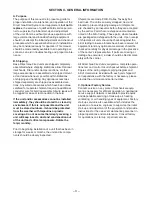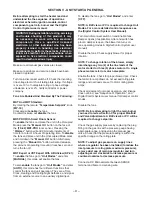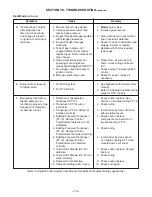
– 2 –
*IMPORTANCE NOTICE*
LJ Wing assumes no responsibility for loss or damage
in transit; therefore, you should protect yourself by
following these instructions:
Bill Of Lading
Save your bill of lading. It is a contract, and you will
need it, provided you have to
fi
le a loss or damage
claim. Remember, claims are outlawed after nine
months.
Loss In Transit
Before you sign for this shipment, check against the bill
of lading, also the transportation company’s delivery
ticket. Make sure that you get the exact total of articles
listed. Should the delivery ticket show more or less
items than are offered, then the carrier’s agent must
mark the difference on your freight bill before you sign.
Visible Damage In Transit
If anything is damaged, accept the shipment only if
the carrier’s agent places a notation on your freight
bill explaining the nature and extent of damage. Upon
inspection of article, make claim to the delivering
carrier.
Concealed Damage In Transit
Sometimes transit damage is not noticed until the
goods are unpacked. In such cases, noti
fi
cation to
the carrier must be made within
fi
fteen (15) days of
receipt of shipment. In such cases, save the packages
and packing material, then notify the transportation
company at once, and request an inspection. When
the inspector calls, have him make out and leave a
“concealed” bad order report. He is obliged to give one
to you. Insist on it.
Disposition Of Damaged Atticles
Never return damaged articles to us. They are the
property of the transportation company when the claim
is
fi
led. They will give you disposition instructions.
Packing
We comply with the packing requirements of the
transportation companies, and your bill of lading
proved that everything was in good condition when
shipped. That bill of lading contract requires them to
deliver in perfect condition.
SECTION I - FOREWARD
As is the case with any
fi
ne piece of equipment, care
must be taken to provide the proper attention to the
operation and maintenance details of this machine.
This manual of instructions along with the Digital
Control System user manual has been prepared in
order for you to become well-acquainted with those
details, and in doing so, you will be able to give your
Direct Gas-Fired System the care and attention which
any piece of equipment needs and deserves.
It is the customer and installation personnel
responsibility to determine if the unit is equipped
with all of the safety devices required for the
particular application. Safety considerations
include the accessibility of the unit to non-service
personnel, the provision of electrical lockout
switches, maintenance procedures, and automatic
control sequences. Clearly mark all emergency
shutoff devices.
Table of Contents
Section I: Foreword, Table of Contents,
and Important Notice .................................. 2
Section II: General Information .................................... 3
Section III: Installation ................................................. 4
Section IV: Pre-Start Up .............................................. 8
Section V: Unit Start Up ............................................... 9
Section VI: Unit Shut Down ....................................... 11
Section VII: Troubleshooting Guide ........................... 12
Section VIII: Maintenance Schedule
and Lubrication Requirements............... 24
Section IX: Mestek Burner ......................................... 29
Section X: Manifold and Valve Adjustments .............. 30
Section XI: Thermistor Curves ................................... 31
Section XII: Replacement Parts................................. 32
Section XIII: Recirculating Units ................................ 32



































